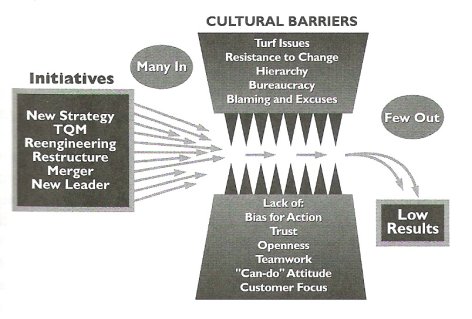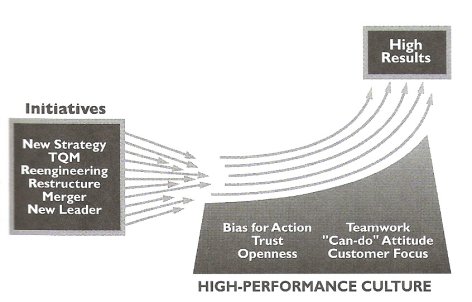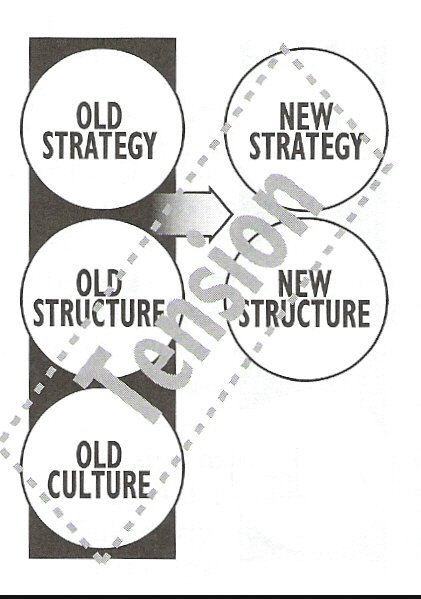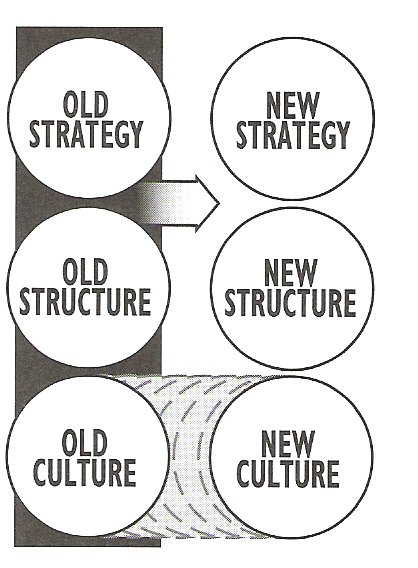- Home
- Corporate culture
Corporate Culture
Corporate Culture Change isn't rocket science or black magic, just follow the right steps.....
THE JAWS OF CULTURE
How healthy is your culture?
WHY CHANGE INITIATIVES FAIL: IT?S THE CULTURE, DUMMY!
Between plans and reality lie years of habits, customs, unwritten ground rules, parochialism, and vested interests: the culture. Culture cannot only stop a change effort dead in its tracks, it can also propel it to great heights.
Wisdom is understanding the power of culture and how to get it to work for you, instead of against you, during organizational change.
Why is it that initiatives and strategies with great promise don't live up to their expectations? A window of competitive opportunity is evident; sound planning and processes are often in place, but the advantage doesn't fully materialize.
The story often sounds like some version of the following:
The numbers showed the merger would really payoff, but we've lost some key customers: Our best executives are leaving for other companies, and we seem to be having a real clash of cultures.
The reorganization was supposed to have broken down the barriers between divisions and created a more collaborative organization. Instead, we seem to have created new boundaries and turf issues.
The new strategy sounded great, but we haven't been able to execute it with our slow-moving, risk-averse bureaucratic culture.
The new I.T. system was supposed to be up and running last quarter, saving us time and money. There is a lot of finger-pointing going on now because it's behind schedule and it looks like it won't deliver all we thought it would.
The analysis showed we'd make dramatic savings through reengineering, but they haven't come through yet. Where are the results? And why is everyone so upset?
We just completed another record quarter, and I know I should be feeling good. The fact is, I'm paying too big a price personally to get results around here and I don't know if I want to stay in this game.
We've got a few great quality improvement teams in place, but it is not widespread. We haven't been able to build it into the fabric of the organization.
More than just anecdotal evidence exists that change initiatives fail more often than they succeed.
A Harvard Business Review article by Nohia and Berkley cites a survey showing that 75 percent of the managers polled were unhappy with change initiatives underway.
Since the current business environment warrants these initiatives, why do they fail?
The answer is clear.
Most change initiatives focus on the operational and technical side. What they too often ignore, or, at best, give lip service to, is the human side-the behavioural side of change.
Anyone who has ever attempted to implement a change of any kind has experienced the phenomenon of resistance to change by people and institutions.
It is easier to decide on change than to get people to change!
People and organizations are creatures of habit, and changing habits is much harder than changing structures or systems.
It seems that organizations, like people, had personalities, and to ignore or not deal with an organization's personality trails could be fatal to your change efforts.
Today, people recognize those personality traits as Corporate Culture, and the business world is slowly beginning to appreciate the power of cultural habits. Most change initiatives have at least token elements of "change management."
Unfortunately, most organizations don't address cultural barriers as vigorously or systematically as needed.
It has long been known that the only way to ensure the maximum success of any broad-based change initiative is to systematically deal with the corporate culture.
To truly change the corporation, you need to change the culture.
It is also interesting to note that James Champy, in Reengineering Management, states:
Everything we've learned drives toward one solid conclusion: The rules of governance (and self-governance) for effective business enterprises today are being determined by their culture, not their organizational structure.
In the past two decades, many new approaches have emerged to improve business performance.
Too often, however, a new theory appears and is hailed as "the answer" only to be later tossed aside as ineffective.
We now know that this repeating pattern has less to do with the quality of the ideas than it does with the corporate culture that ground it down.
Trying to apply improvement methods to an unreceptive corporate culture is like trying to apply a Band-Aid underwater.
There's nothing wrong with the Band-Aid, but it won't stick and therefore it's ineffective.
So Just how do we make the changes stick ?
Some organizations benefited greatly from self-managed teams, empowerment, or TQM, but most tried them, decided they didn't work, and moved on to the next quick fix.
It wasn't that the theories didn't have value (even when they weren't absolutely perfect), it's that they were applied to an incompatible culture where the new approaches couldn't "take."
The reason it's hard to implement change, that teams are often dysfunctional, and people are so stressed at work, is because of what is known as the 'Jaws of Culture'.
To get more details on how you can change Your corporate culture, simply fill in the enquiry form at the foot of this page. Or, better still - buy the book!
Highly recommended:
A corporation's culture can be its greatest strength when it is consistent with its strategies. But a corporate culture that prevents a company from meeting competitive threats, or from adapting to changing economic or social environments, can lead to the company's stagnation and ultimate demise.- Business Week More change initiatives, from strategy to I.T. systems to merger to reengineering, fail as a result of corporate culture issues than any other single factor. If the cultural barriers were well understood and addressed, a much higher percentage of change efforts would achieve their potential. Just a few of the cultural barriers that cause change initiatives to fail are . Hierarchical structure and top-down leadership style. Internal competition between departments-turf and "we-they". Heavy entitlement mind-set and poor empowerment. Lack of accountability, excessive blaming. An "observer-critic" culture that kills new ideas. Communication barriers. Resistance to changing the status quo. Reinforcement systems that ignore customer satisfaction. Non-participative management style-boss-driven command and control. Lack of trust in the company and between groups. Top management calls for behavior change but doesn't walk the talk. All change initiatives must pass through the Jaws of Culture - most get chewed-up, spat out, and forgotten long before they ever accomplish their objectives. The jaws consist of the major cultural barriers that form the ingrained habit patterns of company and individual behavior. While each company and each team is different, they all have their own barriers that comprise their Jaws of Culture. What are yours Culture barriers are often hidden in the fabric of the organization and are difficult to see without the aid of a comprehensive Corporate Culture audit. Cultural barriers can quickly show up in dysfunctional behaviors once the change initiative begins Key among the early behavioral signs of cultural resistance are . Reluctance to accept ideas from other organizations (the "not invented here" syndrome). Turf issues and power struggles. Groups forming under the protection of a politically strong individual that distance themselves from the change process. Senior management having other priorities that prevent sufficient personal involvement and visibility. Lip service and "malicious obedience" The "observer-critic" syndrome in which all new ideas are challenged. People and groups blaming one another. Hierarchical rigid structure. Bureaucracy and resistance to change. This may be getting a little overwhelming but this should give you an insight into how your lean manufacturing efforts fit in with your Corporate Culture Most organizations and leaders, no matter how successful, face some dysfunction in their teams. Getting results and implementing change extracts too high a price. What is the cost of your group or company's cultural barriers? Here at "Beyond lean" we work in partnership with the world leading cultural change experts - SDL. To get more information on how you can change YOUR corporate culture please complete the enquiry form below. Special thanks to Senn Delaney Leadership for the content contained on this page and their kind permission for it's use. 2003 Senn-Delaney Leadership Consulting Group, LLC. All rights reserved? Changing the Corporate Culture Making Change Stick - A pragmatic approach based on hard won experience.
Corporate Culture Examples
A corporation's culture can be its greatest strength when it is consistent with its strategies.
But a corporate culture that prevents a company from meeting competitive threats, or from adapting to changing economic or social environments, can lead to the company's stagnation and ultimate demise.
-Business Week
More change initiatives, from strategy to I.T. systems to merger to reengineering, fail as a result of corporate culture issues than any other single factor.
If the cultural barriers were well understood and addressed, a much higher percentage of change efforts would achieve their potential.
Just a few of the cultural barriers that cause change initiatives to fail are
. Hierarchical structure and top-down leadership style
. Internal competition between departments-turf and "we-they"
. Heavy entitlement mind-set and poor empowerment
. Lack of accountability, excessive blaming
. An "observer-critic" culture that kills new ideas
. Communication barriers
. Resistance to changing the status quo
. Reinforcement systems that ignore customer satisfaction
. Non-participative management style-boss-driven command and control
. Lack of trust in the company and between groups
. Top management calls for behavior change but doesn't walk the talk
All change initiatives must pass through the Jaws of Culture - most get chewed-up, spat out, and forgotten long before they ever accomplish their objectives.
The jaws consist of the major cultural barriers that form the ingrained habit patterns of company and individual behavior.
While each company and each team is different, they all have their own barriers that comprise their ”Jaws of Culture”. What are yours ?
THE COST OF CORPORATE CULTURE
Culture barriers are often hidden in the fabric of the organization and are difficult to see without the aid of a comprehensive Corporate Culture audit.
Cultural barriers can quickly show up in dysfunctional behaviors once the change initiative begins
The Cost of an Ineffective Corporate Culture
Key among the early behavioral signs of cultural resistance are
. Reluctance to accept ideas from other organizations (the "not invented here" syndrome)
. Turf issues and power struggles
. Groups forming under the protection of a politically strong individual that distance themselves from the change process
. Senior management having other priorities that prevent sufficient personal involvement and visibility
. Lip service and "malicious obedience"
·The "observer-critic" syndrome in which all new ideas are challenged
. People and groups blaming one another
. Hierarchical rigid structure
. Bureaucracy and resistance to change
This may be getting a little overwhelming but this should give you an insight into how your lean manufacturing efforts fit in with your Corporate Culture
Most organizations and leaders, no matter how successful, face some dysfunction in their teams.
Getting results and implementing change extracts too high a price. What is the cost of your group or company's cultural barriers?
Here at "Beyond lean" we work in partnership with the world leading cultural change experts - SDL.
To get more information on how you can change YOUR corporate culture please sign up for our Lean Six Sigma Training, including sections on changing your Corporate Culture
Special thanks to Senn Delaney Leadership for the content contained on this page and their kind permission for it's use.
“© 2003 Senn-Delaney Leadership Consulting Group, LLC. All rights reserved”.
Changing the Corporate Culture






